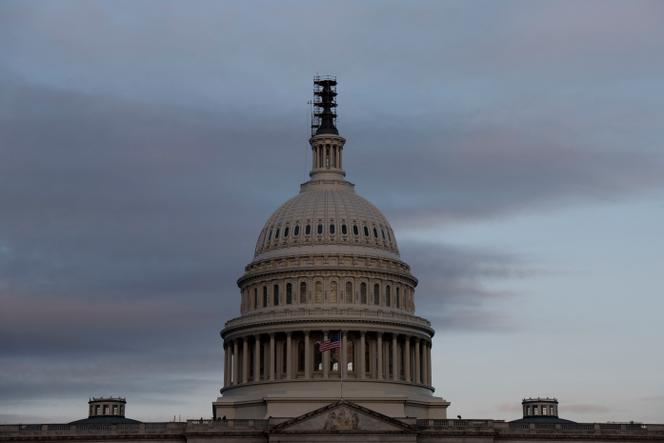


The countdown is on: the United States is heading for another shutdown – a cessation of non-essential government operations due to insufficient funding. The legislation that currently finances federal government operations expires on Saturday, September 30. This means that any part of the administration whose appropriations bill has not been passed and signed by midnight on October 1, the start of the 2024 fiscal year, will shut down.
This paralysis, which threatens federal government services, comes just four months after the world's leading economy came close to defaulting on its debts. It is the consequence of a political deadlock in Congress between the Democratic-majority Senate and the Republican-controlled House of Representatives.
The US Constitution requires the Senate and House of Representatives to vote on the federal budget after a lengthy process. Each year, the White House prepares a draft budget for the following year's fiscal year, which begins on October 1. Joe Biden presented his on March 9 in Philadelphia.
Then, from March to June, 12 sub-committees in each chamber are responsible for distributing the appropriations for the federal government for each department (defense, agriculture, justice, etc.) and examining requests from the executive branch.
The Senate and the House of Representatives each produce a bill. The two texts are discussed from July to October. These debates regularly turn into a tug-of-war, with each side raising the specter of shutting down federal services to extract concessions from the other, usually with a last-minute resolution.
This year's budget crisis could have repercussions beyond the United States, all the way to Ukraine. The White House had initially demanded that the budget bill passed by elected representatives include $24 billion (€22.7 billion) in military and humanitarian aid for Kyiv. However, a bill circulating in the Senate on Tuesday provided for only a quarter of this sum, around $6 billion (€5.7 billion).
Meanwhile, in the Republican-dominated House of Representatives, Speaker Kevin McCarthy is under pressure: he wants to tie support for Ukraine to plans for new restrictions on migrants seeking asylum in the USA. However, the Trump adherents, to whom he owes his position as Speaker of the House, want to stop aid to Ukraine altogether.
Donald Trump injected himself into the debates by urging congressional Republicans, on his network Truth Social, to withhold funding from "all aspects of Crooked Joe Biden’s weaponized Government that (…) treats half the Country as Enemies of the State."
A shutdown would have consequences for millions of Americans, with the impact varying according to the duration and scope of the federal government's paralysis. The Federal Employees Union (AFGE) estimates that "up to 4 million military and civilian employees will be affected," of whom "2.2 million are federal employees," the remainder being "active duty military and reservists."
The Committee for a Responsible Federal Budget (CRFB), a bipartisan organization, points out that during the shutdowns of 2013 and early 2018, "approximately 850,000 of the 2.1 million federal employees (excluding the Postal Service) were furloughed." The organization lists the services affected, from air traffic controllers and Transportation Security Agency (TSA) officials to rangers working in national parks.
"Some 1.3 million serving soldiers will be working without pay," estimated John Kirby, coordinator of the National Security Council, in a video posted on the White House's Instagram account.
Two food aid programs could also be affected: WIC, a nutrition assistance program that nearly 7 million women and children depend on, "affecting nearly half of all babies born in this country," according to the White House, and the Supplemental Nutrition Assistance Program (SNAP, formerly known as food stamps), which serves 40 million low-income Americans.
CRFB pointed out that some essential services "would continue to operate" – border protection, hospital medical care, air traffic control, law enforcement and power grid maintenance. "Some legislative and judicial personnel have also been largely protected" during previous shutdowns, the organization noted.
The shutdown would also have a modest impact on the economy. According to economists at Goldman Sachs, each week of shutdown could cost between 0.15 and 0.2 points of growth in US GDP in the 4th quarter. They stressed that the same impact would be felt in the 1st quarter of 2024.
Since 1976, there have been 21 shutdowns, 10 of which led to federal employees being laid off. The most serious crisis occurred in 1995-1996 under President Bill Clinton, and the longest government shutdown, which lasted 35 days, occurred between 2018 and 2019 when President Trump and congressional Democrats clashed over his funding request for a border wall with Mexico.
At present, Congress has not passed any of the 12 projects being considered in subcommittees in either the House or Senate for fiscal 2024. Failing agreement, a continuing resolution (an interim budget proposal) could be adopted.
The Washington Post noted that the federal government began notifying federal employees of the impending shutdown on Thursday, with a message announcing that "during this period, some will be temporarily placed on leave, while others, who perform exceptional duties, will continue to perform their assigned tasks."
Translation of an original article published in French on lemonde.fr; the publisher may only be liable for the French version.
